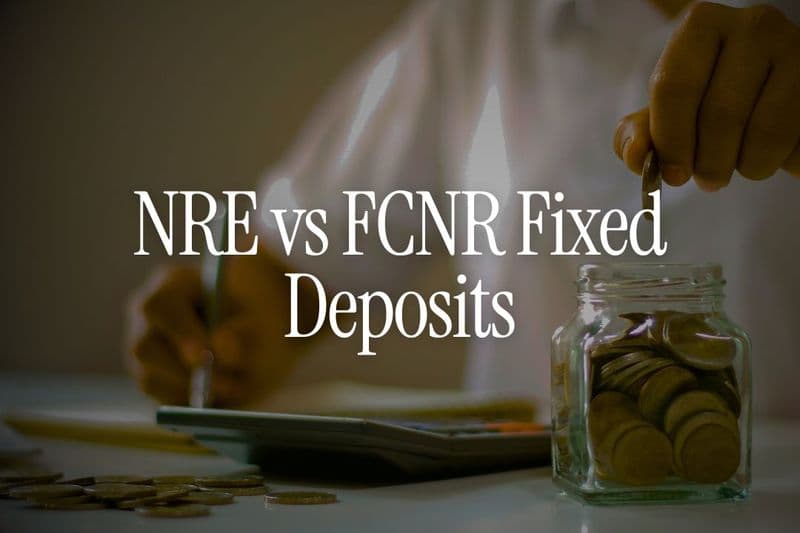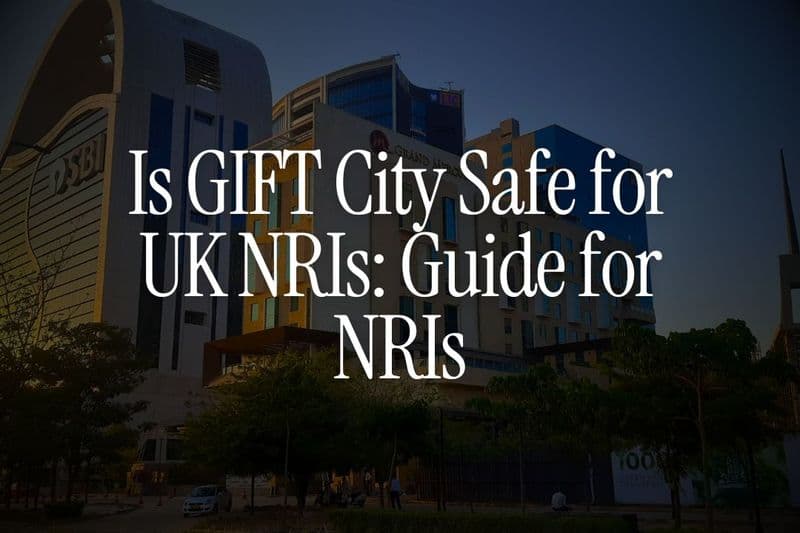
Looking for the best fixed deposit option as an NRI but confused between NRE and FCNR deposits? You're not alone.
At Belong, we help hundreds of NRIs in the UAE navigate this exact dilemma every month through our WhatsApp community and app.
The choice between NRE FD and FCNR FD isn't just about interest rates-it's about protecting your wealth from currency fluctuations while maximizing your USD returns.
This guide breaks down everything you need to know to make the right decision for your financial goals.
NRE Fixed Deposits vs FCNR Fixed Deposits
NRE Fixed Deposits are rupee-denominated term deposits where you invest your foreign currency (converted to INR) for a fixed tenure. Interest earned on NRE term deposits is exempt from Indian income tax, making these FDs very attractive.
Your deposit earns interest in rupees, but when you repatriate, you're exposed to currency exchange rate fluctuations.
FCNR Fixed Deposits (Foreign Currency Non-Resident deposits) let you park your money in foreign currencies like USD, GBP, or EUR directly. FCNR accounts help protect your interest against currency risks since both principal and interest remain in foreign currency.
Think of it as a hedge against rupee depreciation.
Current Interest Rates: The Numbers That Matter
NRE FD Interest Rates (November 2025)
SBI offers NRE FD rates ranging from 6.25% to 6.85% depending on tenure, while IndusInd Bank offers the highest rates at 6.50% p.a. for retail deposits under ₹2 crores.
Here's what major banks are offering:
- SBI: 6.25% - 6.60% p.a.
- ICICI Bank: 6.5% - 7.3% p.a.
- HDFC Bank: 6.5% - 6.9%
- Axis Bank: 6.5% - 7.0% p.a.
FCNR FD Interest Rates (November 2025)
FCNR USD deposit rates typically range from 3.00% to 6.00% p.a. depending on the bank and tenure. Here's what banks are offering for USD deposits:
- Tamilnad Mercantile Bank: 5,25% p.a.
- Yes Bank: 5.00% p.a.
- South Indian Bank: 4.8-% p.a.
- IDBI Bank: 4.75% p.a.
👉 Tip: Indian banks are offering much higher FCNR interest rates compared to term deposits in other countries. Compare this with US CD rates of just 0.02%-1.01% for similar tenures.
Currency Risk: The Game Changer for USD Returns
This is where things get interesting for USD-focused returns. Let's look at a practical scenario:
Scenario 1: NRE FD
- Initial investment: $100,000
- Exchange rate at investment: ₹88.74/USD = ₹88,74,000
- NRE FD rate: 6.5% p.a. (1 year)
- Maturity amount: ₹94,53,110
If the rupee weakens to ₹91.50/USD at maturity: USD return = ₹94,53,110 ÷ 91.50 = $103,343.
Effective USD return: 3.34%
Scenario 2: FCNR FD
- Initial investment: $100,000 (stays in USD)
- FCNR USD rate: 4.25% p.a. (1 year)
- Maturity amount: $104,250
Effective USD return: 4.25%
The FCNR FD wins despite the lower nominal interest rate because there's no currency conversion risk.
Tax Implications: Both Are Tax-Free, But There's More
Interest earned on both NRE and FCNR fixed deposits is exempt from income tax in India. However, tax implications in your country of residence may vary.
For UAE residents:
- No personal income tax on FD interest
- Both NRE and FCNR remain completely tax-free
- Check our Residential Status Calculator to confirm your tax status
For US/UK residents:
- May need to declare FD interest in local tax returns
- DTAA benefits may apply-consult with tax advisors
👉 Tip: Use our Compliance Compass tool to check your tax compliance requirements across different countries.
Repatriation Rules: Full Freedom for Both
Both NRE and FCNR deposits offer full repatriability of principal and interest. There are no restrictions on transferring maturity proceeds to your overseas account.
NRE FD Repatriation:
- Convert INR to your desired currency at current rates
- No limit on repatriation amount
- Bank charges for currency conversion apply
FCNR FD Repatriation:
- Direct transfer in the same currency
- No conversion charges
- Faster processing since no currency exchange involved
Also Read -How to Repatriate Funds from NRO/NRE Accounts
Tenure Options: Flexibility vs Lock-in
NRE Fixed Deposits:
- Minimum tenure: 1 year
- Maximum tenure: 10 years
- No interest paid on premature withdrawal before 1 year
FCNR Fixed Deposits:
- Tenure ranges from 1 year to 5 years
- More rigid tenure options
- No interest payable if withdrawn before one year
Also Read - Which bank is best for fixed deposit in india
Who Should Choose What?
Choose NRE FD if:
- You believe the rupee will remain stable or strengthen
- You want higher nominal interest rates
- You plan to spend the money in India eventually
- You're comfortable with currency risk
Choose FCNR FD if:
- You want to protect against rupee depreciation
- You need funds in USD/foreign currency
- You prioritize capital preservation over higher returns
- You're risk-averse regarding currency fluctuations
The GIFT City Alternative: A Third Option
While comparing traditional NRE and FCNR FDs, consider GIFT City USD Fixed Deposits as a modern alternative. GIFT City FDs are completely tax-free in India and offer attractive rates that outperform FCNR deposits.
GIFT City USD FD benefits:
- Tax-free returns in India
- USD-denominated like FCNR
- Competitive interest rates (often 4.5-6% p.a.)
- Full repatriability
- Regulatory oversight by IFSCA
At Belong, we offer GIFT City USD Fixed Deposits through our app with rates that often exceed traditional FCNR options. Check current rates and compare with your other options.
Making the Smart Choice: Our Recommendation Framework
Based on our experience helping NRIs make this decision, here's our framework:
For Conservative Investors (Risk Level: Low)
- 70% FCNR FD or GIFT City USD FD
- 30% NRE FD
- Rationale: Protect most of your wealth from currency risk while taking some exposure to higher rupee returns
For Moderate Investors (Risk Level: Medium)
- 50% FCNR/GIFT City USD FD
- 50% NRE FD
- Rationale: Balanced approach to risk and return
For Aggressive Investors (Risk Level: High)
- 30% FCNR/GIFT City USD FD
- 70% NRE FD
- Rationale: Higher exposure to potentially better returns, accepting currency risk
👉 Tip: Don't put all your eggs in one basket. Our NRI FD Comparison Tool helps you compare rates across all options in real-time.
Recent Market Trends and Future Outlook
Rupee Performance: Track the latest INR vs USD trends using our Rupee vs Dollar Tracker. Over the past year, the rupee has shown volatility, making currency hedging through FCNR more attractive.
Interest Rate Environment: FD interest rates in India have fallen consistently over the last 12 years, but they still remain significantly higher than global rates. This makes both NRE and FCNR attractive compared to deposits in other countries.
Practical Steps to Open Your FD
For NRE FD:
- Open an NRE savings account first
- Transfer funds from overseas
- Choose tenure and bank based on our rate comparison
- Complete KYC documentation
For FCNR FD:
- Can be opened directly with foreign currency
- Fund through fresh remittance from overseas or transfer from other NRE/FCNR accounts
- Submit currency declaration form if amount exceeds USD 5,000
- Choose from available currencies (USD, GBP, EUR, CAD, AUD, JPY)
Also Read - Banks Offering the Highest FCNR Deposit Rates
For GIFT City USD FD:
- Download the Belong app
- Complete digital KYC
- Fund with USD from overseas
- Enjoy tax-free returns with IFSCA regulatory protection
Key Regulatory Guidelines to Remember
Being an NRI, you cannot open normal savings or FD accounts in India. You can only open NRO, NRE, or FCNR accounts as per your needs.
RBI Guidelines:
- Both accounts are fully compliant with FEMA regulations
- No restrictions on repatriation
- Interest earned qualifies for tax exemption if you maintain 'person resident outside India' status
Documentation Required:
- Valid Indian passport
- Overseas address proof
- PAN card (mandatory)
- Bank statements from overseas account
👉 Tip: Use our Aadhaar linking guide to ensure your documents are properly linked before starting the FD process.
Bottom Line: Which Offers Better USD Returns?
The answer isn't straightforward-it depends on currency movements and your risk tolerance. Based on current market conditions:
If rupee weakens by more than 3% annually: FCNR FD typically offers better USD returns despite lower nominal rates.
If rupee remains stable or strengthens: NRE FD offers better USD returns due to higher interest rates.
For guaranteed USD preservation: FCNR FD or GIFT City USD FD are your best options.
Our recommendation? Start with a conservative approach using FCNR or GIFT City USD FDs to protect your base capital, then gradually add NRE FD exposure as you become more comfortable with currency risk.
Take Action Today
Don't let analysis paralysis prevent you from earning better returns on your money. Join thousands of NRIs who've made smarter investment decisions through our platform.
Next Steps:
- Join our WhatsApp Community to get expert advice from our team and fellow NRIs
- Download the Belong app to explore GIFT City USD Fixed Deposits with competitive rates
- Use our tools and calculators to compare current rates across all banks
Remember, the best FD is the one that aligns with your financial goals and risk tolerance. Whether you choose NRE, FCNR, or explore GIFT City alternatives, make sure you're making an informed decision based on current market conditions and your personal circumstances.
Sources:




